SUBFAMILY FORMICINAE - Genus Cataglyphis
| The Ants
of Egypt SUBFAMILY FORMICINAE - Genus Cataglyphis |
In Tribe FORMICINI, previously in Tribe PRENOLEPIDINI. Reviewed down to the species-group level by Agosti (1990: 457).
Diagnostic Features - Legs very long. Antennae 12-segmented and inserted very close to the posterior margin of the clypeus. Eyes and ocelli present, the eyes set behind the mid-length of the head. Mandibles strongly dentate. Psammophore on the anterior ventral surface of the head. Metapleuron with a distinct wide orifice for the metapleural gland; the orifice protected by a line or tuft of guard hairs. Propodeal spiracle an elongate vertical or near-vertical ellipse. Petiole nodiform or squamiform node. Acidopore borne on a conical projection of the hypopigium and surrounded by a fringe of hair.
Foerster's (1850b) genus definition (of the male) is at ![]() . Mayr's (1855: 381) definition of Monocombus
(synonymised with Cataglyphis by Mayr, 1861: 44) is at
. Mayr's (1855: 381) definition of Monocombus
(synonymised with Cataglyphis by Mayr, 1861: 44) is at ![]() . Agosti's (1990) review is at
. Agosti's (1990) review is at ![]() .
.
Key to workers - based on Emery (1906b), Agosti (1990a) and Collingwood & Agosti (1996, Saudi Arabia key)
| 1 | 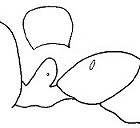 Petiole
high and squamiform; mandible with six or more teeth, maxillary palp
with segments 3 & 4 very long, laterally with a fringe of long
hairs; whole of body or at least alitrunk covered with golden or
silvery pubescence; gaster also with golden pubescence Petiole
high and squamiform; mandible with six or more teeth, maxillary palp
with segments 3 & 4 very long, laterally with a fringe of long
hairs; whole of body or at least alitrunk covered with golden or
silvery pubescence; gaster also with golden pubescence |
bombycinus-group - 2 |
| -- |  Petiole
nodiform domed to narrow conical Petiole
nodiform domed to narrow conical |
3 |
| . | bombycinus-group | . |
| 2 |  Dimorphic, soldier TL
15 mm, minors TL 5.5-8.0 mm, soldier
with falciform mandibles, with a cleft posterior to the apical tooth;
erect hairs on maxillary palp segment 3 at least as long as half the
segment; gaster brown (separation according to Kugler, 1981) Dimorphic, soldier TL
15 mm, minors TL 5.5-8.0 mm, soldier
with falciform mandibles, with a cleft posterior to the apical tooth;
erect hairs on maxillary palp segment 3 at least as long as half the
segment; gaster brown (separation according to Kugler, 1981) |
Libya east to Egypt - bombycinus |
| minor |  |
|
| -- | 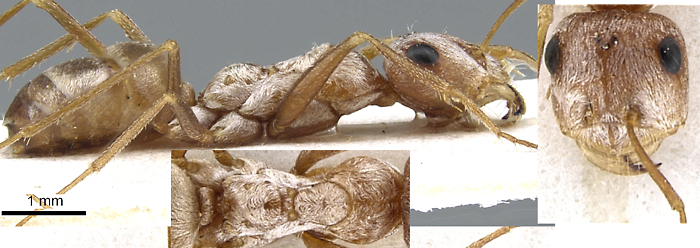 Workers
only with variable size but no major known; erect hairs on maxillary
palp
segment 3 between one-third and half as long as the segment; gaster
never more than light brown Workers
only with variable size but no major known; erect hairs on maxillary
palp
segment 3 between one-third and half as long as the segment; gaster
never more than light brown |
southern Israel & northern Sinai - sabulosus |
| -- | 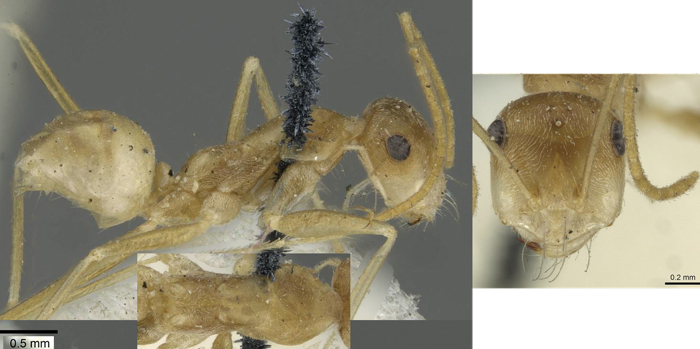 TL 3.5-4.5 mm; mandible with
five teeth, sometimes with extra denticles; if falcate then denticles
always indicated; gaster with sparse pubescence; body chestnut-brown or
yellow, borders of gaster brownish, shining - the pallidus type
location is Turkestan and the single Egypt record seems more
likely to be sabulosus or the minor of bombycinus. TL 3.5-4.5 mm; mandible with
five teeth, sometimes with extra denticles; if falcate then denticles
always indicated; gaster with sparse pubescence; body chestnut-brown or
yellow, borders of gaster brownish, shining - the pallidus type
location is Turkestan and the single Egypt record seems more
likely to be sabulosus or the minor of bombycinus. |
pallidus-group - pallidus |
| -- | 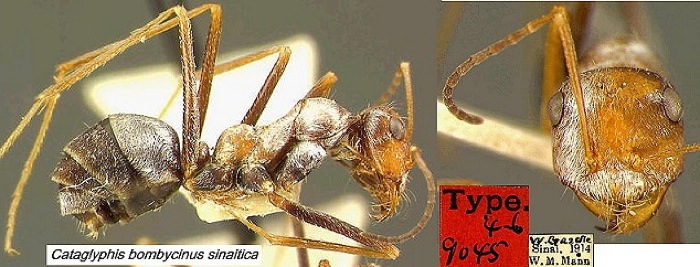 Workers
only with variable size but no known soldier; propodeum with domed
prfile; gaster dark brown under whitish pubescence Workers
only with variable size but no known soldier; propodeum with domed
prfile; gaster dark brown under whitish pubescence |
southern Israel & northern Sinai - sinaiticus |
| . | Petiole nodiform | . |
| 3 |  Gaster not raised in
locomotion; large eyes (EI, eye
length x 100/head wdth > 35); petiole with narrow profile - no Egypt
records, included for comparison; TL to 8 mm Gaster not raised in
locomotion; large eyes (EI, eye
length x 100/head wdth > 35); petiole with narrow profile - no Egypt
records, included for comparison; TL to 8 mm |
altisquamis-group - mauritanicus complex - mauritanicus |
| -- | Gaster raised in locomotion; smaller eyes (EI < 35) | 4 |
| 4 | 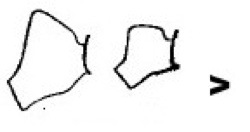 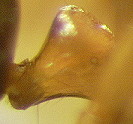 Petiole with anterior face and dorsum meeting at an angle;
TL rarely reaches 9 mm Petiole with anterior face and dorsum meeting at an angle;
TL rarely reaches 9 mm |
albicans-group - 5 |
| -- |  Petiole
wholly domed; TL of majors more than 9 mm Petiole
wholly domed; TL of majors more than 9 mm |
bicolor-group - 10 |
| . | albicans-group, albicans complex and lividus complex | . |
| 5 | Gaster at least black; remainder red or black | albicans complex - albicans, ruber, minimus - 6 |
| -- | Unicolourous, wholly yellow | lividus complex - lividus, argentatus - 9 |
| 6 | Bicoloured, with head and alitrunk either red-orange, or yellowish-orange, with the gaster black | 7 |
| -- | Entirely black and shiny | 8 |
| 7 | 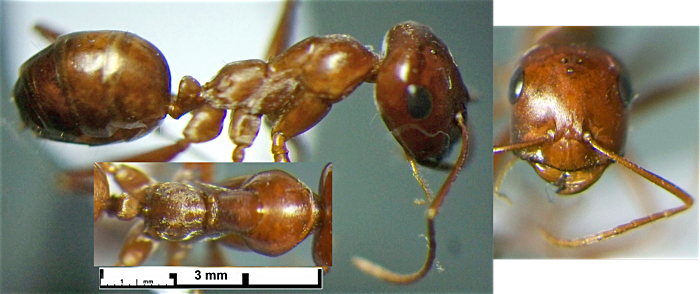 TL
4.8-7.0 mm; head finely sculptured, shagreened, so that only wekly
shiny; head in full face view with smoothly convex occiput;
clypeus with evenly arcuate anterior margin, and a median carina;
petiole profile narrowly domed; head, alitrunk and petiole red to
orange red, gaster black; without silky pubescence; gaster shagreened,
shiny; mandibles longer and more strongly crossed; generally more
slender; very active and aggressive TL
4.8-7.0 mm; head finely sculptured, shagreened, so that only wekly
shiny; head in full face view with smoothly convex occiput;
clypeus with evenly arcuate anterior margin, and a median carina;
petiole profile narrowly domed; head, alitrunk and petiole red to
orange red, gaster black; without silky pubescence; gaster shagreened,
shiny; mandibles longer and more strongly crossed; generally more
slender; very active and aggressive |
ruber |
| -- |  TL (monomorphic, or minor only known) 5.5-6 mm; head
smooth and shiny; head in
full face view with weakly convex convex occiput; petiole profile
angular; gaster shiny black TL (monomorphic, or minor only known) 5.5-6 mm; head
smooth and shiny; head in
full face view with weakly convex convex occiput; petiole profile
angular; gaster shiny black |
franchettii- new status |
| 8 |  TL 3.75-8.0 mm;
uniform shiny black (? piceous-brown) - HW of largest worker > 2 mm,
scape shorter than HW; petiole node with flat slope height to length
4.5 : 4; head sculptured TL 3.75-8.0 mm;
uniform shiny black (? piceous-brown) - HW of largest worker > 2 mm,
scape shorter than HW; petiole node with flat slope height to length
4.5 : 4; head sculpturedEgypt specimens with a major apparently with a much lighter head than the type description |
. |
| . | 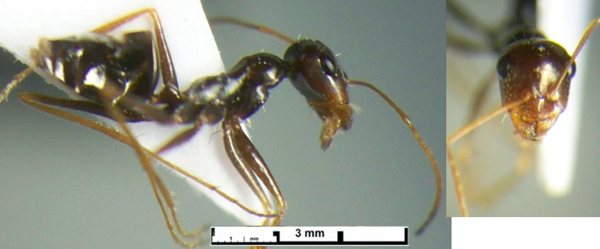 Minor Minor |
albicans |
| -- |  TL 10.79 mm, HL 3.32, HW
2.73,
SL 3.56, SI 130.4; clypeus without a carina; hind femur near = to
alitrunk
length TL 10.79 mm, HL 3.32, HW
2.73,
SL 3.56, SI 130.4; clypeus without a carina; hind femur near = to
alitrunk
length |
agostii |
| 9 |  Unicolourous,
wholly yellow rust, gaster clear yellow;
head sculptured matt or submatt Unicolourous,
wholly yellow rust, gaster clear yellow;
head sculptured matt or submatt |
lividus |
| -- | TL 5 mm; pale rufous or ferruginous, with the upper surface of the head, pedicel, femora and gaster densely covered with short, decumbent whitish hairs, silky, with a silvery reflection; head large; antennae inserted at the border of the clypeus; which is triangular with a median carina; the mandibles strong, flattened with five teeth; ocelli feebly indicated; propodeum weakly narrowed and dorsally concave; petiole scale narrow and rounded; legs strong; gaster rounded almost spherical. | argentatus |
| . | bicolor-group | . |
| ¤ | Queen only known | bicoloripes |
| 10 | Petiole distinctly longer than wide | 11 |
| -- | Petiole relatively short | 14 |
| 11 |  TL 7.0-9.5 mm; overall
smaller and most of head and body
somewhat shinier, with reduced sculpturation; gaster by contrast is
less shiny than bicolor with a heavier sculpture that matches
the rest of the body; not known from Egypt TL 7.0-9.5 mm; overall
smaller and most of head and body
somewhat shinier, with reduced sculpturation; gaster by contrast is
less shiny than bicolor with a heavier sculpture that matches
the rest of the body; not known from Egypt |
abyssinicus complex - abyssinicus |
| -- | 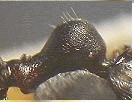 Relatively low profile
to the petiole, lower than long;
unicolorous, very dark red to black Relatively low profile
to the petiole, lower than long;
unicolorous, very dark red to black |
niger complex - holgerseni, niger and savignyi - 12 |
| . | niger complex | . |
| 11 |  Propodeum high, relatively
massive with dorsum and
declivity junction a rounded right angle; no TL given; apparently with
a somewhat purplish tinge Propodeum high, relatively
massive with dorsum and
declivity junction a rounded right angle; no TL given; apparently with
a somewhat purplish tinge |
holgerseni |
| -- | Propodeum dorsum and declivity junction smoothly rounded | 13 |
| 13 | 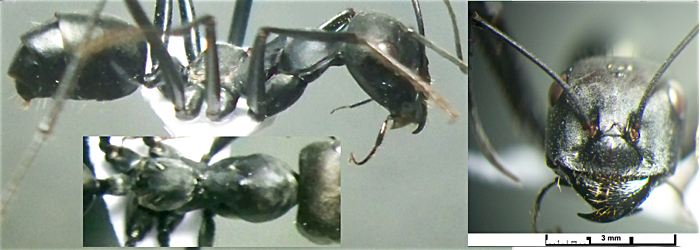 Entirely
black with the gaster matt as with the rest of the body, TL between 5.0
and 12 mm; mandibles with pronounced striations Entirely
black with the gaster matt as with the rest of the body, TL between 5.0
and 12 mm; mandibles with pronounced striations |
niger |
| -- |  Bicoloured,
head and alitrunk dark rust, gaster very dark red, rather than black;
coxae, trochanters, femora and tibiae black; matt; TL 8.5 mm Bicoloured,
head and alitrunk dark rust, gaster very dark red, rather than black;
coxae, trochanters, femora and tibiae black; matt; TL 8.5 mm |
savignyi |
| . | Petiole relatively short | . |
| 14 | Petiole node with angular summit | 15 |
| -- | Petiole node smoothly domed | 17 |
| 15 |  Petiole
high and angular; TL 9-13 mm; head noticeably longer than wide; clypeus
with a straight median anterior margin and no carina; head &
alitrunk dull orange; gaster opaque, black; yellow erect hairs on the
occiput and white pubescence on the hind tibiae; probably not
present in Egypt Petiole
high and angular; TL 9-13 mm; head noticeably longer than wide; clypeus
with a straight median anterior margin and no carina; head &
alitrunk dull orange; gaster opaque, black; yellow erect hairs on the
occiput and white pubescence on the hind tibiae; probably not
present in Egypt |
viaticus-group - viaticus |
| -- | 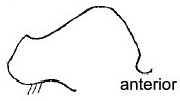 Petiole a low node with an relatively narrow summit and a
straight anterior face Petiole a low node with an relatively narrow summit and a
straight anterior face |
setipes complex - 16 |
| 16 |  Red
a little darker than the type bicolor (although less so than desertorum),
appendages as the body; gaster matt black; occipitum, lower head and
gaster and legs somewhat shiny; sides of thorax and femora pubescent;
lower head, thorax and gaster pilous; upper body glabrous - not
known from Egypt but possible in southern Egypt/Sahel area? Red
a little darker than the type bicolor (although less so than desertorum),
appendages as the body; gaster matt black; occipitum, lower head and
gaster and legs somewhat shiny; sides of thorax and femora pubescent;
lower head, thorax and gaster pilous; upper body glabrous - not
known from Egypt but possible in southern Egypt/Sahel area? |
congolensis |
| -- |  Quite
brightly coloured species with the somber red head and alitrunk
contrasting with the brilliant unsculptured dark gaster; workers with
short funiculus segments (as in diehlii) and a high short
petiole node Quite
brightly coloured species with the somber red head and alitrunk
contrasting with the brilliant unsculptured dark gaster; workers with
short funiculus segments (as in diehlii) and a high short
petiole node |
laevior - new complex allocation |
| -- | 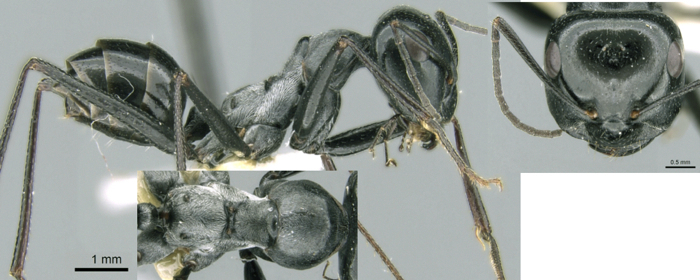 TL 6-9 mm; clypeus distinctly
carinate; long hind legs
(hind femur 1.72 x alitrunk length); head and body relatively dark
red-brown, gaster black TL 6-9 mm; clypeus distinctly
carinate; long hind legs
(hind femur 1.72 x alitrunk length); head and body relatively dark
red-brown, gaster black |
for comparison (from Tunisia) - fortis |
| . | Petiole relatively short and smoothly domed | . |
| 17 | 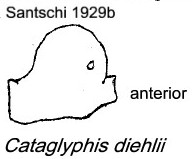 Petiole node a forward titled dome; generally dark, with
gaster black or nearly Petiole node a forward titled dome; generally dark, with
gaster black or nearly |
diehlii complex - adenensis, diehlii and isis - 18 |
| -- | Petiole node not angled forward | 19 |
| . | diehlii complex | . |
| 18 |  Gaster dark contrasting with red head; HL approx = HW;
petiole dorsum mildly flattened; petiole squamiform Gaster dark contrasting with red head; HL approx = HW;
petiole dorsum mildly flattened; petiole squamiform |
adenensis |
| -- |  Head and alitrunk finely sculptured and somewhat opaque,
gaster
smooth and shiny; weakly
polymorphic, TL range 5.0-9.2 mm; majors with relatively small heads
(cf viaticus & bicolor); propodeum amd petiole
scale with greyish pubescence; entirely black except sometimes majors
with slightly red heads. Head and alitrunk finely sculptured and somewhat opaque,
gaster
smooth and shiny; weakly
polymorphic, TL range 5.0-9.2 mm; majors with relatively small heads
(cf viaticus & bicolor); propodeum amd petiole
scale with greyish pubescence; entirely black except sometimes majors
with slightly red heads. |
diehlii |
| -- | 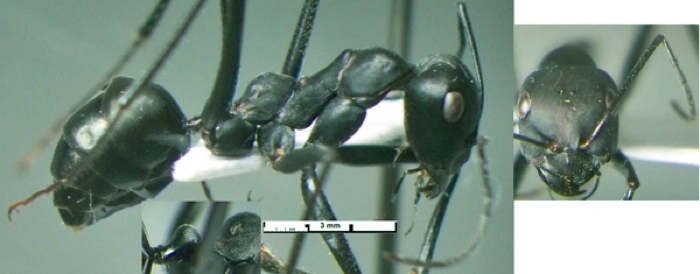 Gaster mildly sculptured and
dull; scape with occasional erect hairs; body evenly dark, mandibles
reddish; differs from diehlii in having a strongly pubescent
alitrunk and occasional erect hairs on the scapes. TL not exceeding 9.5
mm. Gaster mildly sculptured and
dull; scape with occasional erect hairs; body evenly dark, mandibles
reddish; differs from diehlii in having a strongly pubescent
alitrunk and occasional erect hairs on the scapes. TL not exceeding 9.5
mm. |
isis |
| . | Petiole node not angled forward | . |
| 19 | 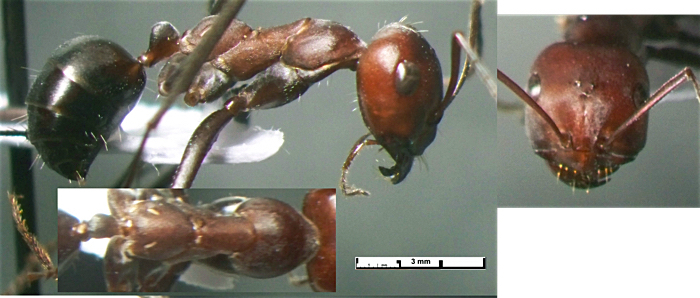 Petiole
node lowest dome of group, relatively square; TL 5.0-12.7 mm; fine
close short pubescence on the tibiae and tarsi; no erect hairs on the
scapes; colour always clear red, darker on the largest workers, gaster
black; the sole identification from Egypt seems likely to have been
wrong (specimens here from Iran) Petiole
node lowest dome of group, relatively square; TL 5.0-12.7 mm; fine
close short pubescence on the tibiae and tarsi; no erect hairs on the
scapes; colour always clear red, darker on the largest workers, gaster
black; the sole identification from Egypt seems likely to have been
wrong (specimens here from Iran) |
nodus complex - nodus |
| -- |  Bicoloured workers which have appressed white to yellow
pubescence on the hind tibiae; petiole as high as long. Bicoloured workers which have appressed white to yellow
pubescence on the hind tibiae; petiole as high as long. |
bicolor complex - bicolor
and desertorum - |
| . | bicolor complex | . |
| 20 | 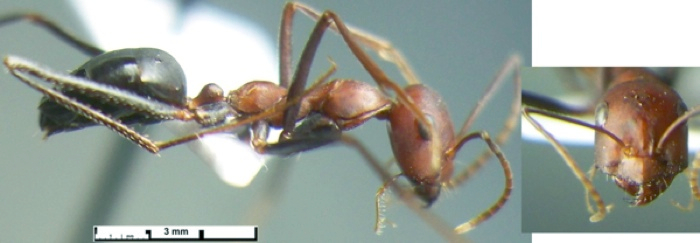 Type (Santschi, 1929b)
pronotum with very weak pubescence, quite abundant on sides of
propodeum and legs; major worker with legs red as with the body,
brownish in smaller workers; (Wehner et al, 1994) black erect hairs on
the occiput and black pubescence on the hind tibiae Type (Santschi, 1929b)
pronotum with very weak pubescence, quite abundant on sides of
propodeum and legs; major worker with legs red as with the body,
brownish in smaller workers; (Wehner et al, 1994) black erect hairs on
the occiput and black pubescence on the hind tibiae |
bicolor |
| -- |  More robust with
relatively short legs; petiole perhaps a little higher; propodeum not
domed in profile; matt except for occipitum; very dark red, scape
darker than rest of head, appendages brown red; tarsi with dense black
setae and coarse black pubescence (decumbent setae) More robust with
relatively short legs; petiole perhaps a little higher; propodeum not
domed in profile; matt except for occipitum; very dark red, scape
darker than rest of head, appendages brown red; tarsi with dense black
setae and coarse black pubescence (decumbent setae) |
desertorum new status |
|
©2006, 2009, 2010, 2015 - Brian
Taylor CBiol FRSB FRES 11, Grazingfield, Wilford, Nottingham, NG11 7FN, U.K. |
href="cataglyphis.htm"